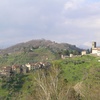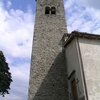Castle of Corsagna
The castle at Corsagna most likely stood at the top of the small hill where today there is the Church of San Michele Arcangelo. The location of the castle allowed control of a large part of the Serchio Valley.
The precocious decommissioning of the ancient fort of Corsagna may indicate that it belonged to the Suffredinghi family and was destroyed during the wars between the city of Lucca and “nobles” of the Garfagnana basin.
The bell-tower of the Church of Saint Michael dates back to the 11th and 12th centuries and its massive form and the type of masonry techniques used means it most certainly had a military function. This also supports the hypothesis of the existence of a fortified original core. The church, cited in the agricultural valuations of the diocese of Lucca in 1260, then replaced the castle becoming the main monument of the community, as evidenced by documents dating back to the 13th and 14th centuries.
The current building, with three naves, dates from the 15th century and houses interesting paintings from the 16th and 17th centuries, such as the Circumcision by Alessandro Frediani (XVII sec.), and the sixteenth-century altarpiece (Madonna with Child and Saints) by Giovanni Gherardo Chain.
A road, mostly unpaved, leads into the large wooded area of Pizzorne, which is of great interest for hiking and cycling.
Historical notes
The first mention we have of Corsagna dates all the way back to 768, and throughout the Middle Ages it was the subject of great interest being a feud of the Suffredinghi family. At the end of the 10th century, the town was listed among the places under the parish Saint Stephen of Barga.










